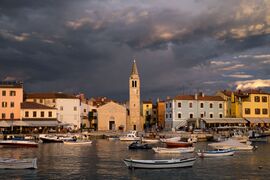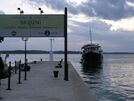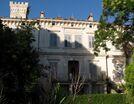فجانا
Fažana
Fasana | |
|---|---|
Municipality | |
| Fažana Municipality Općina Fažana - Comune di Fasana[1] | |
| الإحداثيات: 44°56′N 13°48′E / 44.933°N 13.800°E | |
| Country | Croatia |
| County | Istria County |
| الحكومة | |
| • Mayor | Ada Damjanac |
| المساحة | |
| • الإجمالي | 1٬386 كم² (535 ميل²) |
| التعداد (2012) | |
| • الإجمالي | 3٬569 |
| • الكثافة | 2٫6/km2 (6٫7/sq mi) |
| منطقة التوقيت | UTC+1 (CET) |
| • الصيف (التوقيت الصيفي) | UTC+2 (CEST) |
| Postal code | 52212 |
| Area code | 052 |
| الموقع الإلكتروني | www |
Fažana (النطق الكرواتي: [faʒǎna]; Italian: Fasana, النطق بالإيطالية: [fazaːna]) is a village and a municipality on the western coast of Istria, in Croatia. Fažana is a picturesque fishing village on the southwest coast of the Istrian peninsula. [2]
Name
Fasana, which in Roman times carried the name of Vasianum and then Phasiana, derives its name from the presence in Roman times of ceramic and terracotta manufactures such as vases, tiles and amphorae.[3] Its name and meaning thereof is also reflected in the symbol of the town, an amphora.[3]
التاريخ
Roman times
Fasana is a village of Roman origin. Its territory was part of the Roman Empire by 177 BC.[4] It belonged to the Roman colony of Pola, both politically and administratively.[4] During Roman times, Fasana was an important economic center of the Ancient Roman civilization.[4] Its importance during Roman times was due to its manufactures, production of olive oil[4] and later amphorae.[3] The Ancient Roman factory of Fasana, located in the old center of the town, was noted for its production of ceramics and bricks.[4] The production of amphorae started during the latter part of the reign of Augustus, and lasted until the second century AD. In these amphorae were stored the local products, such as grain,[5] salted fish[5] and, most importantly, the Istrian oil and wine, the two most valuable products of the Istrian peninsula during Roman times.[4] The workshop belonged to the local Lecanii family, and its first known owner was praetor urbanus Caius (Gaius) Laecanius Bassus.[4] A striking aspect of the recovered amphorae are the signatures of the workers who worked in the factory.[3]
Its proximity to the sea made fishing an important feature of the town already in Roman times. It was a safe heaven, where Roman mercantile ships could dock, and where it was possible to live, work, and go on vacation.[4][3] Its importance as a patrician holiday town is shown by the finding of many Roman villas in the area.[6] Among them is the so-called Roman Villa of Valbandon, located at 2 kilometers from the center of Fasana.[3] It is a residential complex divided into two groups of buildings.[3] Discovered at the beginning of the 20th century, it features beautiful floors with floral and geometric patterns.[3][5]
Middle Ages
In the 6th century AD, the Church of Sant'Eliseo was built in Fasana over the foundations of a palace from the Later Roman Empire period. The Later Roman Empire palace, built a century earlier, had been used as a vacation house.[5] The small Church of the Santa Maria del Carmelo was built in the 14th century. It features frescoes from the 15th century.[5]
Also in the 15th century was built by the sea the Church of Santi Cosma e Damiano. It is characterized by Gothic elements and features a 27-meter tall bell tower and Renaissance paintings from the 16th century, including Giorgio Ventura's Ultima Cena from 1598.[7][5]
الجغرافيا
The city is located by the sea, 8 kilometers northwerst of Pola.[5] Just before it lie the islands of Brioni (Brijuni).[5]
The territory of Fasana includes, beside the fishing village, the Ronzi valley to the south, the coast of Peroi in the north, and the town's hinterland, consisting of olive groves and vineyards.[4] The town's importance during Roman times was due precisely to its production of olive oil.[4]
Notable people
- Mario Carlin (1915–1984), Italian tenor
- Gaius Laecanius Bassus (fl. 32–40 AD), Roman praetor urbanus and consul
- Gaius Laecanius Bassus (fl. 64 AD), Roman consul
المراجع
- ^ The official site, see also the list of towns and municipalities Archived 2014-03-11 at the Wayback Machine in the Istria County (ref. to [1]) and the narodne-novine list (ref. to [2])
- ^ "ISTRA.HR". www.istra.hr (in الكرواتية). Retrieved 2023-04-30.
- ^ أ ب ت ث ج ح خ د "Fasana Romana". www.informagiovani-italia.com. Retrieved 3 May 2023.
- ^ أ ب ت ث ج ح خ د ذ ر "Fasana ai tempi di Roma". www.istra.hr (in الإيطالية). Retrieved 3 May 2023.
- ^ أ ب ت ث ج ح خ د Travirka, Antun (2001). Sokota, Zivko (ed.). Istria. Zadar: Forum. p. 88; 95. ISBN 953-179-470-7.
- ^ "Fasana". www.istria-croazia.it. Retrieved 3 May 2023.
- ^ "Chiesa Santi Cosma e Damiamo a Fasana in Istria". www.informagiovani-italia.com. Retrieved 3 May 2023.
| Fažana
]].
- Pages using gadget WikiMiniAtlas
- CS1 الكرواتية-language sources (hr)
- CS1 الإيطالية-language sources (it)
- Short description is different from Wikidata
- Coordinates on Wikidata
- Populated coastal places in Croatia
- Municipalities of Croatia
- Populated places in Istria County
- Italian-speaking territorial units in Croatia
- فجانا










